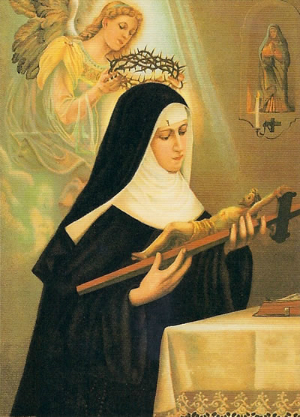
She also continued to advocate for peace throughout Cascia. Augustine by immersing herself in prayer and works of charity. Augustine of Hippo, Nicholas of Tolentine, and John the Baptist, Rita was able to bring the families together and she joined the convent at age thirty-six.įor the next forty years, Rita followed the Rule of St. It was agreed, though, that she could enter the community if she would peacefully reconcile the feuding families. The convent was afraid that the harmony of the community would be ruined if Rita joined since members of the rival family who murdered her husband were members of the convent. She was refused, but she was persistent and asked for entry again. She again felt the calling to religious life and tried to enter the Augustinian convent in Cascia. Throughout it all and despite losing her husband and sons, Rita continued to have faith and fully trust in God’s providence. They shortly died, but not before asking God for forgiveness. Instead they joined their uncle in the feud, but before they could execute their plans, they became deathly ill. Rita, after publicly pardoning her husband’s murderers, tried in vain to disuade her twin sons from taking revenge. The family feud, however, was becoming more violent and Paolo, betrayed by one of his allies, was killed. He begged Rita for forgiveness and became more amiable. He would verbally and physically abuse his wife, had infidelities, and was involved with a family feud between the Chiqui and Mancini families.Įventually, through Rita’s influence of humility, kindness, and patience, Paolo changed his ways and became a better person. Paolo turned out to be a cruel man with a violent temper and many enemies. In obedience to her parents, Rita married him and during their 18 years of marriage, she bore and raised him two sons. However, thinking of her safety and security, her parents promised her in marriage to a man named Paolo Mancini. They considered Rita’s birth as a gift from God as they were already advanced in years by the time she was born.įrom an early age, Rita longed to become a nun and she would frequently visit the convent of the Augustinian nuns in Cascia. She was the only child of Antonio and Amata Lotti, who were known as peacemakers in their community.

Saint Rita of Cascia was born in a village called Roccaporena, near Cascia, Italy in 1381. The life of Saint Rita of Cascia is a perfect example of what can happen when you trust in God even when things seem impossible. Few of those choices were made in ideal circumstances-not even when Rita became an Augustinian nun.SummarySaint Rita of Cascia, born Margherita Lotti, was an Augustinian nun known as a peacemaker and patron saint of impossible cases, abused women, and parents. Her overarching, lifelong choice was to cooperate generously with God’s grace, but many small choices were needed to make that happen.

Rita became holy because she made choices that reflected her baptism and her growth as a disciple of Jesus. An “If only ….” approach to holiness never quite gets underway, never produces the fruit that God has a right to expect. Many people visit her tomb each year.Īlthough we can easily imagine an ideal world in which to live out our baptismal vocation, such a world does not exist. She has acquired the reputation, together with Saint Jude, as a saint of impossible cases. She also counseled lay people who came to her monastery.īeatified in 1626, Rita was not canonized until 1900. Her care for the sick nuns was especially loving. She meditated frequently on Christ’s passion. When she developed wounds on her forehead, people quickly associated them with the wounds from Christ’s crown of thorns. Over the years, her austerity, prayerfulness, and charity became legendary. Unsuccessful at first because she was a widow, Rita eventually succeeded. After her husband was killed in a brawl and her sons had died, Rita tried to join the Augustinian nuns in Cascia.

During her 18-year marriage, she bore and raised two sons.

Her holiness was reflected in each phase of her life.īorn at Roccaporena in central Italy, Rita wanted to become a nun but was pressured at a young age into marrying a harsh and cruel man. Like Elizabeth Ann Seton, Rita of Cascia was a wife, mother, widow, and member of a religious community. Image: The Translation of Saint Rita of Cascia | Nicolas Poussin


 0 kommentar(er)
0 kommentar(er)
